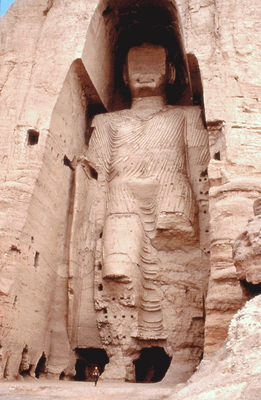Can Memories of Kindness Survive?
By Diana Reynolds Roome
I vividly remember balancing myself in a bitter wind on the head of the tallest standing Buddha in the world. When I heard the Taliban religious militia had fulfilled its threat to blow up the great Buddhas in Afghanistan, I felt a shudder of annihilation, as though I were still there on top of the statue. In fact, I was safely separated by more than three decades — a blip in the existence of the Buddhas, built more than 1,500 years before and half a world away.
The hard-line Taliban Muslims, who rule Afghanistan, ordered the statues destroyed last month, saying they are idolatrous. Foreign aid workers report the demolition has been completed.

The larger of the two Buddhas prior to the 2001 destruction.
Carved like a vertical mummy out of red-gold sandstone cliff, the large Buddha was higher than the Statue of Liberty. The 53-metre climb to the top was arduous, leading around the back and inside the statue. I emerged on the ushnisha, or top-knot, which was the size of a suburban bedroom, with no protective railings. Though the drop was giddying, the sight of the distant snowy peaks of the Hindu Kush mountains steadied me. A little closer, the smooth silver-grey flanks of the Koh-i-Baba mountains stood out luminous as a photographic negative in the evening half-light.
Stretching along the valley were tall rocks honeycombed with caves, once dormitories, halls, shrines, and now eerily deserted. Hsuan-tsang, a Chinese priest, came here in 632, the same year that Mohammad died at Medina.
“There are more than 10 monasteries and more than a thousand priests,” he wrote in his book, Travels in Western Countries. Modern estimates calculate the caves at 20,000, far outnumbering the human population of Bamiyan.
On the sloping rock around Buddha’s head, were frescoes, mutilated like the carvings, flaking with age and neglect, but still magnificent. In siena, umber, vermilion and faded lapis blue, they seemed as much a feat of engineering as art. The difficulty of working at this height and on a concave rock recalled Michelangelo’s labours in the Sistine Chapel, a thousand years later.
As a gust of wind pushed me roughly, I knew these painters had endured capricious weather too. Mists were swirling into the valley as the sky grew rapidly darker. I’d been so transfixed, I hadn’t noticed I was up here quite alone, with no sign of my travelling companions and guide.
Peering down, I tried to locate our little guesthouse. Two figures in fur coats and pointed hats, shot out of the walls of its compound, precariously balanced on bucking horses. Speeding towards the stern wall of mountains, they disappeared. Their rush made me acutely aware of the icy stillness where I stood. Shrinking into a corridor, I came out on the Buddha’s shoulder. Alone under the huge, bell-shaped ear, I felt a sense of total insignificance. This Buddha would stand forever.
Scurrying down the worn steps inside the great Buddha, I heard the tread of footsteps. My first instinct was fear. But suddenly, our Muslim guide, who was also the clerk at the only bank for over 150 kilometres, appeared. I was never so grateful to see someone who was hardly more than a stranger. Grasping me firmly by the hand and elbow, he led me back down the Buddha.
My guide’s small kindness survived years in my memory. The Buddhas stood for ages, bearing witness to the supreme truths of non-violence and compassion. In destroying them, Afghanistan may have cut itself off from what it needed most.
